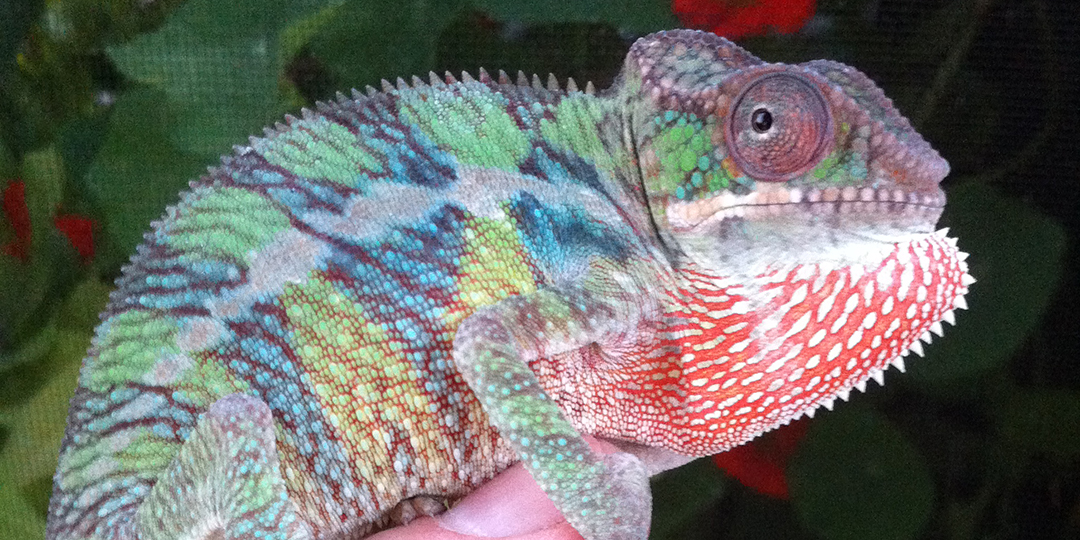S7 Ep34: Top Five Ways to Give Your Chameleon a Better Life
Hello Chameleon Academy! Welcome to the podcast that is all about chameleons. This week I challenged myself to come up with five simple ways that you can dramatically increase the quality of life for your chameleon.
Embedded Video Player
Embedded Podcast Episode Player
Transcript (more or less)
Introduction
When you first start out with chameleons there is so much you need to absorb and do. Of course, the first time you do anything the results will not match the textbook! So this podcast episode is for the keeper that has gotten their set-up and their chameleons. The dust has settled a little bit and you are looking at what is next. Well, I have put together my five top picks for increasing the quality of life for your chameleon. The baseline assumption is that you are giving the proper environment in a cage that is at least the minimum recommended. Once you have fulfilled the basic care sheet requirements then we can consider this next level. I have many episodes on those care sheet basics generally and species specific so if you are just starting off please take a leisurely walk through the past episodes or across the chameleonacademy.com website. But this episode is for when you have your basics down and are ready for the next step!
1) Double Your Cage Space
My first pick is to double your cage space. Can you clear another two feet of space next to your 2x2x4 cage? Might you have another three feet available above your 36” x 18” x 36”? Seriously consider getting another cage, put it by the side or on top of the one you have now and remove the connecting walls. Now, I know this isn’t as simple as just saying it. In fact, I actually bought two ReptiBreeze XLs specifically to make a video tutorial on how to do it. And, no, it is not as straight forward or as easy as you might think. But it is also not horribly difficult and the resulting benefit for your chameleon is immense. Commercially made 4x2x4 cages are still worth it as far as getting a structurally solid, good looking cage, but if you are not in need of moving the cage or to assuage a spouse’s desire for appearance, a cage pair mended together will make your chameleon very happy.
I am going to share with you a few insights that came from me doing it to help this become a thing you think seriously about. And, before I go into this, I want to let you know the information for combining two Reptibreeze XL cages is on the chamelenacademy.com website under the projects section. I have a shopping list and a step by step guide there so I will go over the process here at a high level so you can get an idea of what it takes with the purpose being to inspire you to think about it. But you do not have to try and remember everything! It is all written down for you.
I own the Dragon Strand caging company, but I still went out and actually purchased two Reptibreeze XLs so I could do this tutorial because they are the most common cage out there. So, please do me the favor of giving it serious consideration! This will work or the Reptile Breeze XL or DIYCages.com Jumbo 2x2x4’ cages by just getting another one and putting them side by side. With the Exo-Terra 36”x18”x36” you could put one on top of the other. Or, what the heck, you could put those side by side too if you wished. But this example is with the 2x2x4’ Reptibreeze XL.
The high level idea is that you are going to use coroplast or PVC or some plastic that you can cut into strips and screw those strip onto the frames to connect the cages. Now, you will notice when you put the cages next to each other that they will not be flush because of the pan head screws sticking out. Well, coincidentally, the 1/8” that that creates just happens to be the space you need them to be away from each other so that the latches move freely. So, somehow the universe knew we needed that space. I, personally, got myself black coroplast. That is the material that looks like plastic cardboard and is used for lawn signs. It is easy to cut and work with. You can often find this, at least in white, at your local home improvement store. Once again, I have a shopping list if you are not sure where to find this kind of stuff and want to order online. If you have an Amazon Prime you may as well keep it well exercised.
Now, the one thing that is a little wonky is if you are using Dragon Ledges. Those are the anchor type brackets that you see on the sides and back of cages as they allow you to mount potted plants and horizontal branches to your screen wall. If you already have a Reptibreeze XL with the Dragon Ledges then you just need three more back Dragon Ledges to have a complete set of attachment site s throughout your next 4x2x4 cage. Luckily, Dragon Strand is my company and I put together a bundle of three back Dragon Ledges specifically for this project. I also do a bundle for if you needed Dragon Ledges for both cage halves. These are on the chameleonacademy.com website shopping list, of course, or you can also find them on dragonstrand.com directly.
And then on the inside I put a bead of silicone along the inside seam to avoid an area for feeder insects to escape and hide out.
Honestly, I would love to see the thousands of Reptibreeze XL owners double their cage size with this project. If it is properly set up with plants and such you will give your chameleon their greatest upgrade for quality of life.
2) Drainage tray
Are any of you using paper towels or puppy pads or even reptile carpet to soak up water at the bottom of your cage? Or are you frustrated that water is leaking from your cage onto your furniture? That is the result of not having a drainage tray under the cage to catch the water. But more important than that, allowing the water to seep out of the cage and into the tray below keeps pooling water away from the poop and escaped feeder insects and helps with hygiene. The last thing you need is for a cricket who jumped out of the feeder cup to run through poop soup at the bottom of the cage and then get eaten by your chameleon.
Unfortunately, most cages on the market do not have drainage trays available. Cages made by ZooMed and Exo-Terra only have substrate trays which go inside the cage. Obviously, this is going in the wrong direction as it specifically keeps all the waste water and poop together. This is also why we don’t use those paper towels or puppy pads. Even if they absorb the water, they are still providing a moist environment for bacteria and parasites. The best approach is to have nothing on the floor of the cage that holds the water. The only exception is when you have a soil substrate at the bottom, but even then there is a drainage layer to take care of the excess moisture. Dragon Strand cages should resume offering cage bundles with drainage trays within a month so I look forward to getting that back on that track! But what about the other cages?
You can do a simple DIY project that gives you a drainage tray. You can find trays made for catching oil, replacing the floor in a dog crate, or even a tray to hold artificial grass peeing station for apartment dogs. And our cages will fit onto these trays. Once you have found a tray you will need some sort of standoff so the cage isn’t sitting in the waste water. I make a frame out of 3/4” PVC pipe and set that in the tray and then the cage on top of that.
Next you need to get more drainage in your cage. The standard cages are not water tight and the water seeps around the floor panel. But I suggest you add more drainage to your cage by drilling holes smaller than your feeder insect size all around the PVC floor panel. Pay specific attention to where you have any plants on the floor as those will cause indentations. Make sure there is good drainage on the floor under those potted plants.
If you are using Dragon Ledges or some other method to attach plants to the side of your cage you are able to replace the PVC floor with a screen panel to give essentially 100% drainage. With Dragon Strand I offer these, but you can make one of your own by getting screen panel supplies from your home improvement store. Just make a panel that will fit inside the cage and replace the PVC floor.
And finally, you need a way to remove the water. For this I personally use a wet.dry vacuum and just go around and sucking up excess water once or twice a week. Very easy and convenient. I use the Bucket Head which is an inexpensive wet/dry vacuum that sits on top of a standard 5 gallon bucket. It has served me well for years! Alternatively, you can get garden drip system parts, drill a hole in the tray, and super glue in a 1/4” tubing connector for a gravity drain into a bucket nearby. It won’t get all the water, but it will get most of it!
As always, I have trays for the most common cage footprints on the website under the menu item “projects”. Just find the DIY Drainage tray page. There I have links to trays for 2’x2’, 36”x18”, and 4’x2’ cage footprints and tutorials on how I made the stand-off frame.
3) Feeder Diversity
Now, let’s put some thought into enriching the life of our chameleon. The most obvious way we can do that is by offering different feeders. Not more, but different. Anything flying or green is a quick way to get your chameleon to wake up and chase something across the cage.
House flies are commonly available for purchase and will lead your chameleon on a merry chase. But with so many different feeders available from black soldier flies, to silkworms, to wax worms, to praying mantises, to green banana roaches and the list goes no and on, there is no shortage of what is available to you. Some of these are expensive, but I suggest putting it in your budget to offer one different feeder every two weeks or every month just to shake things up. And don’t worry about waxworks being too fatty or mealworms and whatever is being said about them these days. When things are offered as a treat you are not concerned about the nutritional aspect. This is a mental excitement. So have fun shopping for treat enrichment for your chameleon!
4) Security Check – Height and Cover
If you have been listening to this pod cast or watching the YouTube channel you will have heard many times that chameleons derive security from being above the action and being able to hide. And now is a great time to check and make sure that has been implemented effectively in your cage. The height test is to see if your chameleon’s basking branch is at or above your head level. Chameleons enjoy being. Above the action and get stressed if they are at or below the action level. The action level is your head, by the way!
And then, can your chameleon get to a comfortable perching branch where he feels like he is safely hidden from view from all sides? This usually takes the form of perching branches behind a bunch of plant foliage. And even though we talk about it a lot, it isn’t until you really take a close look at your cage from all sides that you realize that creating this hidden space really isn’t as simple as it sounds – especially if you are using a screen cage! Add to that that we humans can convince ourselves they don’t need a hiding space because they don’t use one. You might be surprised how much it is used once you provide an effective one.
My favorite way to create a hidden layer in a 2x2x4 cage is to mount a large pothos on one side of the cage and another large pothos or spider plant on the other side of the cage. Their leaves combined together make a thick foliage layer which the chameleon can look out from behind, but feel secure that it can’t be seen.
And
5) High Humidity nights.
Humidity has been a husbandry parameter that has not gotten the attention it deserves. But you can see the difference almost immediately when you start including high humidity nights in your husbandry. Regardless of your hydration routine, you will notice a reduction in how much they drink. The reason is that they don’t need to drink as much to stay hydrated when they sleep in a high humidity environment.
What is going on is that all living things lose moisture when they breathe. We do too. That is how we “fog up the windows”. And, of course, we drink to replenish that lost moisture. The one time we cannot do that is when we are sleeping. That is why you wake up and want to drink some water. Time to rehydrate to start the day! And that is what your chameleon needs to do as well. The dryer the air the more moisture is lost and the more dehydrated we become overnight. You can reduce the amount of night dehydration in your chameleon by providing a humid environment up to 100% RH in their cage throughout the night. How you do this depends on what your ambient conditions are. If you have naturally high humidity nights then you have it set already! Otherwise, you can use humidifiers or foggers to raise the cage humidity. I use foggers running through the night. How long they run depends on the conditions. During the dry Santa Ana winds that come through my area my foggers are running all night. During the rare monsoon conditions I don’t use the foggers at all. I open the windows and let those natural ions breeze through. On the Chameleon Academy care summaries I have a sample hydration schedule that includes using a fogger. You can use this schedule to get you started, it is a fogger running from 1Am to 6AM, but you should, as soon as possible, get confident in adjusting your schedule based on how your weather patterns change.
The benefit to your chameleon is that you are reducing the hydration/dehydration swing and keeping its body more closely to the ideal hydration state.
Summary
So, here we have five ways to increase the quality of life for your chameleon. Adding on a second cage to increase your available space is a pretty substantial move as it disrupts your chameleons entire cage for a little while, but the long term benefit of having increased space is worth it.
A drainage tray is almost critical for health and hygiene reasons. I am still amazed at how few people have a drainage tray or drainage solution beyond paper towels and puppy pads. Get yourself a drainage tray and it will not only be better for your chameleon, but better for your ability to maintain the cage!
The security check is self-explanatory. The more secure they feel the less stressed they feel and the long they will live. So, give them their height and leafy sanctuary.
Any enrichment you can give your chameleon is worthwhile. The challenge is knowing what enrichment is for a chameleon. Too many people think that giving them things that would be enriching for a human is a good thing. Taking your chameleon to the store with you or drives around town is not enrichment for a chameleon. It is anthropomorphizing them, which means giving them human qualities. Chameleons are unique and wonderful beings in their own right. We cheat them and ourselves when we try and make them human. But one thing that does make them excited is new food objects. We don’t want to give them the chameleon equivalent of ice cream until they are unhealthy, but doing it every other week is more mental benefit than nutritional problem. So, go ahead, give some fatty waxworms every now and then!
And, finally, our chameleons will benefit if we change our thinking from drinking to the entire hydration condition. By providing high humidity nights we can prevent them from dehydrating during the night and having to make up for it during the day.
Conclusion
Even if you knew all this, it doesn’t hurt to just sit down in front of your chameleons cage with a nice cup of coffee and think about each of these points. It is amazing what I find and want to improve when I do this. And this after having all these things in mind when I put together the cage! Part of the fun of keeping an environment that has a chameleon is the constant improvement.
I would like to thank my Patreon members who are supporting this outreach. There may be 100 chameleons out there that will soon have a mansion to live in and you are helping make that happen!
You can find shopping lists and step-by-step guides for doubling your cage size and creating a drainage tray on the projects menu tab on the chameleonacademy.com website. And be sure to check out the Chameleon Academy YouTube channel where you can see over 200 videos about chameleons and their care. If you are interested in having a live discussion with me I go live on Instagram at 5PM Pacific on Tuesdays and on YouTube live at 8AM pacific on Saturday mornings. Unless I have a video premiere…then we do that and I go live at 8:30AM. Always chameleon adventure to be had throughout the week!
Thanks for sharing this time with me! I wish you all the best and a green banana roach for your chameleon! This is Bill Strand signing off and I will see you next time!












